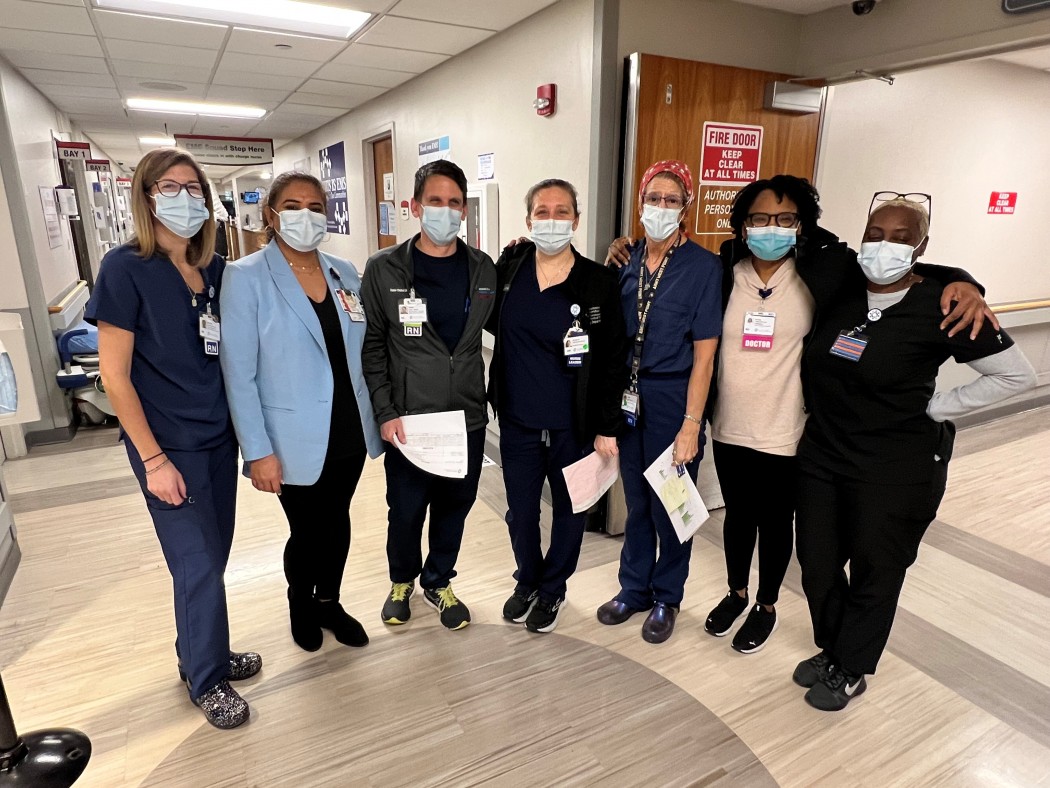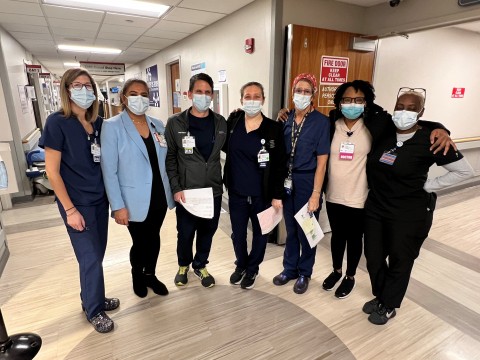Mock Code Stroke

Mock code stroke drills are essential components of training programs that prepare healthcare providers to respond effectively in emergency situations. These drills simulate stroke scenarios that allow the code stroke team to practice skills including, stroke assessments and treatment protocols. At Mountainside Medical Center, code stroke drills are conducted regularly to enhance the hospital’s stroke response, identify areas of opportunity, and ultimately improve outcomes for patients.
Sometimes, patients experiencing stroke-like symptoms drive themselves to an emergency department (ED), or are driven by a friend or loved one, rather than calling 9-1-1 to be transported via ambulance. In this Mock Code Stroke, a patient, Cecile, drove herself to the Mountainside Medical Center ED. Upon registration, the registrar, Tiffany, experienced a glitch in the system and was having difficulties with registering the patient. So as not to delay care, Tiffany alerted the triage nurse, Jo-Ann, that Cecile presented with complaints of a mild headache and blurry vision. Jo-Ann immediately assessed Cecile who shared that around 9:00 a.m., she started to feed a sudden headache and about 20 minutes later, her vision became blurry. Concerned that Cecile may be having a stroke, Jo-Ann quickly called her department director for guidance, escorted her patient to a stretcher and activated a Code Stroke, which ended the mock stroke exercise. A debriefing of the exercise then took place in the ED.
Time is Brain
Quickly recognizing signs and symptoms of a stroke is critical for a healthcare team to activate a Code Stroke. This alerts a multi-disciplinary team from the Emergency Department, Radiology, and other areas that a patient has arrived with stroke symptoms.
Mountainside Medical Center follows the American Heart Association’s (AHA) treatment guidelines for timely management of stroke patients. In fact, the hospital has received the American Heart Association’s Get With The Guidelines® - Stroke quality achievement since 2011 for the hospital’s commitment to ensuring stroke patients receive the most appropriate treatment cording to nationally recognized, research-based guidelines, ultimately leading to more lives saved and reduced disability. The hospital is a designated primary stroke center, recognized by the Joint Commission as a Thrombectomy-Capable Stroke Center, indicating the hospitals’ advanced stroke care capabilities.
BE FAST
Stroke is a leading cause of death and disability in the United States. According to the Centers for Disease Control and Prevention (CDC), someone in the US has a stroke every 40 seconds, and someone dies from a stroke every four minutes. It is essential to recognize the signs of a stroke and seek medical attention immediately.
There is an easy-to-remember acronym to help identify the signs of a stroke: BE FAST.
Balance (loss of balance, dizziness);
Eyes (blurry vision)
Face (one side of face drooping),
Arm (weakness/numbness of arm and/or leg),
Speech (difficulty speaking), and
Time (Call 911 immediately).
If you notice any of these signs, call 911 immediately.
If you are having a stroke, or if you suspect that someone is having a stroke do not drive to the hospital! Dial 9-1-1 for emergency medical services (EMS) to be transported to the nearest emergency room. EMS are trained to recognize the signs of a stroke and can provide life-saving treatment on the way to the hospital. They can also alert the hospital of your arrival and prepare to provide immediate care upon your arrival.
Reduce your risk of stroke with lifestyle modifications, such as maintaining a healthy weight, eating a healthy diet, exercising regularly, not smoking, and limiting alcohol consumption Managing underlying health conditions, such as high blood pressure, high cholesterol, and diabetes, can also help lower the risk of stroke.
To learn more about the Mountainside’s Emergency Services visit www.mountainsidehosp.com/ED.





